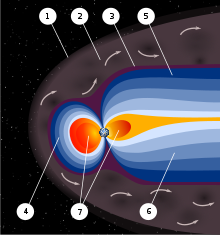From Wikipedia, the free encyclopedia
A rendering of the magnetic field lines of Earth's magnetosphere
A magnetosphere is the area of space near an astronomical object in which charged particles are controlled by that object's magnetic field.[1][2] Near the surface of the object, the magnetic field lines resemble those of a magnetic dipole. Farther away from the surface, the field lines are significantly distorted by electric currents flowing in the plasma (e.g. in ionosphere or solar wind).[3][4] When speaking about Earth, magnetosphere is typically used to refer to the outer layer of the ionosphere,[3] although some sources consider the ionosphere and magnetosphere to be separate.[2]
History
Study of Earth's magnetosphere began in 1600, when William Gilbert discovered that the magnetic field on the surface of Earth resembled that on a terrella, a small, magnetized sphere. In the 1940s, Walter M. Elsasser proposed the model of dynamo theory, which attributes Earth's magnetic field to the motion of Earth's iron outer core. Through the use of magnetometers, scientists were able to study the variations in Earth's magnetic field as functions of both time and latitude and longitude. Beginning in the late 1940s, rockets were used to study cosmic rays. In 1958, Explorer 1, the first of the Explorer series of space missions, was launched to study the intensity of cosmic rays above the atmosphere and measure the fluctuations in this activity. This mission observed the existence of the Van Allen radiation belt (located in the inner region of Earth's magnetosphere), with the Explorer 3 mission later that year definitively proving its existence. Also in 1958, Eugene Parker proposed the idea of the solar wind. In 1959, the term magnetosphere was proposed by Thomas Gold. The Explorer 12 mission in 1961 led to the observation by Cahill and Amazeen in 1963 of a sudden decrease in the strength of the magnetic field near the noon meridian, later named the magnetopause. In 1983, the International Cometary Explorer observed the magnetotail, or the distant magnetic field.[4]Types
The structure and behavior of magnetospheres is dependent on several variables: the type of astronomical object, the nature of sources of plasma and momentum, the period of the object's spin, the nature of the axis whereabout the object spins, the axis of the magnetic dipole, and the magnitude and direction of the velocity of the flow of solar wind.The distance at which a planet can withstand the solar wind pressure is called the Chapman–Ferraro distance. This is modeled by a formula wherein
A magnetosphere is classified as "intrinsic" when
Structure
Bow shock
Magnetosheath
The magnetosheath is the region of the magnetosphere between the bow shock and the magnetopause. It is formed mainly from shocked solar wind, though it contains a small amount of plasma from the magnetosphere.[7] It is an area exhibiting high particle energy flux, where the direction and magnitude of the magnetic field varies erratically. This is caused by the collection of solar wind gas that has effectively undergone thermalization. It acts as a cushion that transmits the pressure from the flow of the solar wind and the barrier of the magnetic field from the object.[4]Magnetopause
The magnetopause is the area of the magnetosphere wherein the pressure from the planetary magnetic field is balanced with the pressure from the solar wind.[3] It is the convergence of the shocked solar wind from the magnetosheath with the magnetic field of the object and plasma from the magnetosphere. Because both sides of this convergence contain magnetized plasma, the interactions between them are very complex. The structure of the magnetopause depends upon the Mach number and beta of the plasma, as well as the magnetic field.[8] The magnetopause changes size and shape as the pressure from the solar wind fluctuates.[9]Magnetotail
Opposite the compressed magnetic field is the magnetotail, where the magnetosphere extends far beyond the astronomical object. It contains two lobes, referred to as the northern and southern tail lobes. The northern tail lobe points towards the object and the southern tail lobe points away. The tail lobes are almost empty, with very few charged particles opposing the flow of the solar wind. The two lobes are separated by a plasma sheet, an area where the magnetic field is weaker and the density of charged particles is higher.[10]Earth's magnetosphere
Over Earth's equator, the magnetic field lines become almost horizontal, then return to connect back again at high latitudes. However, at high altitudes, the magnetic field is significantly distorted by the solar wind and its solar magnetic field. On the dayside of Earth, the magnetic field is significantly compressed by the solar wind to a distance of approximately 65,000 kilometers (40,000 mi). Earth's bow shock is about 17 kilometers (11 mi) thick[11] and located about 90,000 kilometers (56,000 mi) from Earth.[12] The magnetopause exists at a distance of several hundred kilometers off Earth's surface. Earth's magnetopause has been compared to a sieve because it allows solar wind particles to enter. Kelvin–Helmholtz instabilities occur when large swirls of plasma travel along the edge of the magnetosphere at a different velocity from the magnetosphere, causing the plasma to slip past. This results in magnetic reconnection, and as the magnetic field lines break and reconnect, solar wind particles are able to enter the magnetosphere.[13] On Earth's nightside, the magnetic field extends in the magnetotail, which lengthwise exceeds 6,300,000 kilometers (3,900,000 mi).[3] Earth's magnetotail is the primary source of the polar aurora.[10] Also, NASA scientists have suggested or "speculated" that Earth's magnetotail can cause "dust storms" on the Moon by creating a potential difference between the day side and the night side.[14]





